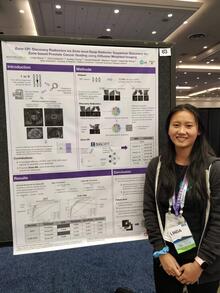
Redirecting research during the pandemic
New master’s grad Linda Wang helped develop an innovative coronavirus screening tool

New master’s grad Linda Wang helped develop an innovative coronavirus screening tool
By Carol Truemner Faculty of EngineeringWhen she started her engineering master’s degree in 2018, Linda Wang had no idea her research would be used to help detect a potentially deadly global virus less than two years later.
 After COVID-19 became a pandemic last spring, Wang and her graduate supervisor Alexander Wong, as well as DarwinAI, a Canadian artificial intelligence startup with strong ties to the University of Waterloo, developed technology that may be used to screen and assess the severity of infected patients.
After COVID-19 became a pandemic last spring, Wang and her graduate supervisor Alexander Wong, as well as DarwinAI, a Canadian artificial intelligence startup with strong ties to the University of Waterloo, developed technology that may be used to screen and assess the severity of infected patients.
The open-source tool, dubbed COVID-Net, is designed to automatically screen COVID-19 infections from chest X-rays and help guide medical professionals on how seriously the infection has taken hold.
Wang, who graduates this week with her master’s degree in systems design engineering, built one of the first neural networks to predict if a person’s X-ray contains COVID and how far has the disease progressed.
“I quickly prototyped it within a week,” she says. “As we developed more partnerships with other hospitals, we continued to fine-tune the model to make it better.”
COVID-Net is now widely used around the world.
In collaboration with the University’s Vision and Image Processing (VIP) Lab, Wang and Wong, a systems design engineering professor who is a director of the lab, also introduced COVIDx, an open-access benchmark dataset they created using about 14,000 chest X-ray images.
Wang’s interest in applying computer vision to medical issues was piqued while she was a Waterloo systems design engineering undergraduate student working in Wong’s lab as a research assistant.
“It felt like Alex’s lab fit very well with my computer vision interests,” she says.
After graduating with her BASc, Wang focused her master’s research on building an AI system for the visually impaired to help them easily and quickly locate objects in a room.
She used her extensive knowledge of computer vision to also work on prostate cancer detection until March of this year when she quickly pivoted her research to help advance the screening of COVID-19.
“The work involves applying the same techniques, but to a different application area,” Wang says.
Her resulting research paper on the COVID-Net initiative is now one of the highest cited articles on detecting COVID-19 from chest radiography.
At the beginning of July 2020, she again pivoted her research, this time into a full-time software engineer position at Lyft Level 5 developing computer vision models for self-driving. In 2019, Wang spent four months as an intern for the Palo Alto-based Lyft, the second largest ride-hailing service in the US.
“My work is similar to what I did for my master’s, but it’s now for self-driving cars,” she says.
She views self-driving as a complex problem for which she can apply the skills and knowledge she learned at Waterloo Engineering to help solve.
“Self-driving will make the roads safer because there will be potentially fewer accidents. It will also provide transportation for those who aren’t able to drive,” she says. “As for me, I’ll be able to do something else in the time it takes to drive.”
As a Waterloo Engineering student, Wang was the recipient of many awards, including the President's Athletic Academic Honour Roll presented to student-athletes who achieve an average of 80 per cent and higher while competing in an inter-university sport. She was honoured with the award for being a member of the Warriors’ varsity swim team during her undergraduate degree.
Specializing in the 200-metre butterfly stroke, Wang spent two hours at practices weekday mornings in the pool at the University’s Physical Activities Complex (PAC) before heading off to engineering classes. Most weekends were spent at swim meets throughout Ontario.
Although she could keep swimming for exercise or training for competitions in the pool of her Mountain View, California apartment, Wang points out there is one big problem.
“The pool’s too short,” she says with a laugh.

Read more
How one student took a leap of faith and learned to count the small victories

Read more
More than 250 Applied Health Students will receive their degrees at fall convocation

Read more
Spotlighting the accomplishments of six exceptional students
The University of Waterloo acknowledges that much of our work takes place on the traditional territory of the Neutral, Anishinaabeg, and Haudenosaunee peoples. Our main campus is situated on the Haldimand Tract, the land granted to the Six Nations that includes six miles on each side of the Grand River. Our active work toward reconciliation takes place across our campuses through research, learning, teaching, and community building, and is co-ordinated within the Office of Indigenous Relations.